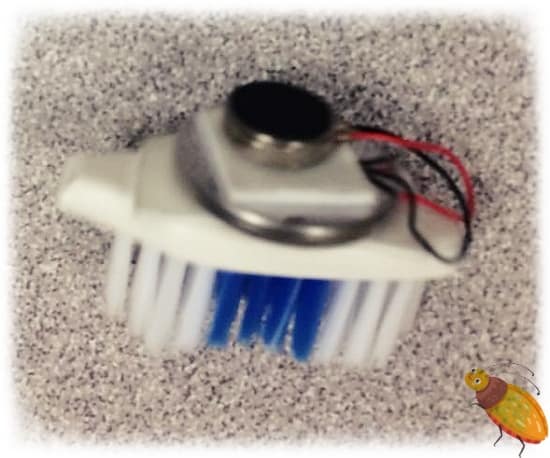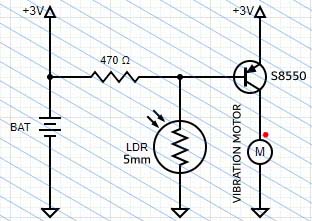Bristlebot is a great easy way for kids to start to learn basic electronics.
Bristlebot is perhaps the simplest form of a walking robot with a rigid bristle toothbrush body. It seems simple, a Bristlebot is made out of the end of a toothbrush with an attached low-mass vibration motor and a battery to power it.

Most everything you need to build it can be bought from the local electronics store, or you probably have it in your junk box right now.
Now what? Be creative and try something different. So, get ready to make a Photosensitive Bristlebot without taking pains, watch your own model e-bug come to life, and enjoy!
Key Parts
- 5mm LDR x1
- 10mm Coin Vibration Motor x1
- S8550 PNP BJT x1
- 470Ω ¼ W Resistor x1 (see notes)
- CR2032 Coin Cell & Holder x1
- Toothbrush Head (hard bristle preferred) x1
Wiring Diagram
Below is the minimalistic wiring diagram of the Photosensitive Bristlebot. Note that the coin vibration motor (also known as pancake vibration motor) has polarity, usually the red wire is the positive lead.

Below is a random snap of my breadboard mock up (all parts taken from the junk box) prepared to test this little concept.

Making Hints
This Photosensitive Bristlebot is an easy-to-construct little robot where the motion is caused by the transfer of kinetic energy from the vibration motor through the body of the robot to the ground. Then the rapid motion of the bristles enables the robot locomotion.
I will not get into step-by-step construction details here. If you look around online you can find lots like this https://www.sciencebuddies.org/stem-activities/toothbrush-bristlebot.
However, let me draw your attention to a few significant things to keep in mind during construction.
First off recall that our Bristlebot is photosensitive so it wakes up and jiggles only when ample light falls on its eye (the photoresistor). The given circuit configuration works well in most situations but you can increase or decrease the light detection sensitivity by changing the value of the 470Ω resistor. You can also put a 15x7mm black heat shrinkable tube on the photoresistor (5mm LDR).
Next, it is highly recommended to use a toothbrush that has at least some slanted bristles so that the engine moves better in one direction. In this project, there is no real right or wrong toothbrush, vibration motor, or battery to choose from – buy and try an assortment of them to pick the right one (but remember that keeping it lightweight is crucial).
Finally, decorate your bot to give it a personality (yes, give it some unique style). Sorry I do not have a fancy prototype to show you it in action yet!

Closing Words
Oh, now I think a little over-engineering would enhance the overall experience. So, see also some betterment ideas below.
- Build it with a 3D printed body
- A solar power source can be added
- A clap or whistle sensor can be added
- A radio/infrared remote control can be added
- A supercapacitor can be used instead of the coin battery
I leave the rest to you.
Bristlebot makes robotics education accessible and affordable. It is an easy way where little STEM kids can leap into to the amazing world of robotics. So, take some time to ignite their interest with this fun project. Be creative with electronics. Have Fun!




A quick live demo of this concept can be seen in this reel https://www.facebook.com/reel/694384809413018